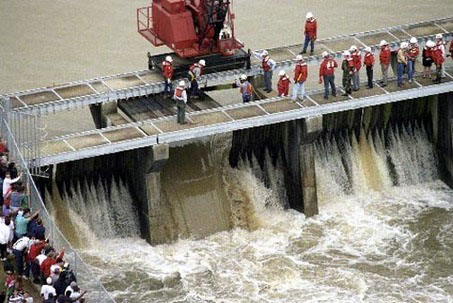 JUST MY OPINION
JUST MY OPINION  THE WATERS COMETH – NOW WHAT?
THE WATERS COMETH – NOW WHAT?
THE WATERS COMETH – NOW WHAT?
 Spillway opening - a scene saltwater commercial and recreational fishermen dread Spillway opening - a scene saltwater commercial and recreational fishermen dread |
As I write this the Bonnet Carre Spillway just upriver from New Orleans is being opened, unleashing Mississippi River water into Lake Pontchartrain and points beyond. While not confirmed at press time the Morganza Spillway just above Baton Rouge appears to almost certainly be opened too, sending water towards the Gulf via wetlands near Morgan City. These are measures necessary to protect lives and properties from floodwaters. These are times when the fish and shellfish resources and the habitat that support them take a seat on the back burner. So just when it looked like we suffered far less harm from last spring’s oil catastrophe than anybody imagined and the wicked winds of April have finally subsided, enter yet another enemy – the muddy waters of the mighty Mississippi.
For the last couple of weeks the question of how this will affect our fishing, shrimping and crabbing this summer has been a hot topic. The best we can do is look back to previous high river years when water had to be diverted, then factor in current conditions and finally make the best guess what the results will be. Here are my observations and predictions based on experience with several openings.
Generally diversion of river water into brackish and saltwater environments have negative short term and positive long term impacts. Short term negatives include displacement of popular finfish including speckled and white trout, redfish, flounder, sheepshead and black drum as well as others. This could mean not finding fish in your traditional spots but ironically could help find fish by congregating them in other places where conditions are optimal. Fishing along salt - fresh lines where they intersect can be productive because many saltwater fish enjoy eating freshwater prey so long as they can tolerate the salinity level while doing so.
Crabs aren’t as mobile as fish so they are more likely to suffer mortality or stunted growth rates in lower salinities and/or low oxygen. The biggest threat to mortality for all species comes from algal blooms. Nutrient–rich river water introduced to warm water spawns microscopic plant growth which causes oxygen depletion and in some rarer cases, toxins. This is when fish and shellfish kills occur. And this being one of the latest spillway openings at a time when water temperatures will be higher than in past years, the size and quantity of these blooms is likely to increase this time around. Fortunately the larger species are able to avoid suffocation simply by vacating the area. Bait fish aren’t so lucky and pogeys, mullet and small croakers are more likely to be victimized by the blooms. These blooms can be deceiving. During the summer of 2008, the last time the spillway was opened, a smelly, blue-green bloom appeared on the northshore along the Lake Pontchartrain Causeway. Everyone thought fishing there would be out of the question, so to prove a point Jeff Bruhl and I fished in it and caught plenty of hungry, healthy speckled trout. Keep in mind saltwater is heavier than freshwater and in deep areas there can be clean, salty, oxygenated water underneath muddy or that pea soup colored water on the surface.
Shrimp will also take a hit, but not long term. Cooler, less salty and poorly oxygenated water promotes poor growth rate and even some mortality. Of course when bait is scarce, fish populations tend to take a temporary dip. The shrimp seasons dates, which I’ll cover in this newsletter, were set with freshwater effects in mind and the Wildlife & Fisheries Commission granted power to the Secretary Barham to make emergency adjustments as developments make them necessary.
From past openings we know the length of time open and the direction of prevailing winds determines the degree of impacts to saltwater species. However, a new factor will have an unknown impact. The rock dam across the Mississippi River Gulf Outlet has changed the hydrology in the Pontchartrain Basin by restricting flow rates. The normal water exchange from Pontchartrain through the Industrial Canal, the Intracoastal Waterway and the MRGO is further impeded by the newly built hurricane protection structure. This will prevent the natural flushing effect and bottle up the river water on the lake’s southeast end leaving only two, not three routes for tidal changes. Nearly all of the river water will have to eventually exit through the two remaining outfalls, the Rigolets and Chef Passes. It will be interesting to see how this blockage affects the whole scenario.
So what about those long term positives? For eons during the pre-levee days, the Mississippi naturally fed life-giving nutrients into coastal wetlands, heck it even built what we know as the Delta. Of course a slow saturation is less harmful than a massive, concentrated dumping of those nutrients. But hey, look at the bright side, the winds have finally broken and given a choice between oil and muddy water, I’ll take the latter every time. Bottom line for anglers, remember how to use those short term negatives to your advantage and appreciate this not-so-perfect and temporary application of Mother Nature’s long term benefits.
Looking back at this past and recent seasons in the lower Mississippi & Central flyway states , what best describes how you rate the waterfowl situation?

